Reviews, reviews, reviews. We got reviews for our product. Each one spreading the word about anime to an even wider, ever-growing audience. Regardless of the reviewer’s taste, these reviews (positive or negative) were important to the eventual U.S. acceptance of anime as another facet of the animation medium.
This week, a few more samples of the critical commentary at the time on Streamline Pictures Video Comics line.
“We can all remember a time when we were the neophyte otaku on the block. Think back to those days when our anime collections consisted of a handful of fourth or fifth generation untranslated copies of whatever series it was that got us hooked on anime in the first place. I’m sure I can safely bet that many of our then tiny collections contained Megazone 23. if you’re in the mood for a trip down anime’s memory lane, the anime classic is now available on this side of the Pacific. However, for those unfamiliar with Megazone 23, here is a brief (Hey! I don’t want to ruin it) plot synopsis. […] Streamline has done a better than average job on the dubbing and retained the original Japanese vocals for Eve’s (MZ 23’s answer to Lynn Minmay) songs. My recommendation to you neo otaku out there (or even to us crusty veterans of anime): Give this classic a place in your library. Gary’s Grade…..A.”
Gary Sprandel, Anime Squared, #4, January 1996, pgs. 5-6
“A glance at the unimaginative package illustration of a generic, bubble-eyed boy and his turbo-charged motorbike isn’t promising. The first half-hour of the 80-minute Mega Zone 23 Part One seems to confirm the viewer’s meagerest expectations, as insufferably perky teens frolic trendily, dropping brand names and riding around on a really neat high-tech, shape-changing motorcycle that seems to be played by an out-of-work Transformer. […] Then, just as the viewer has crossed the film off as a superficial waste of time, Mega Zone switches its high-tech gears and transforms itself into an engrossing science-fiction tale involving a mind-bogglingly vast virtual-reality conspiracy, media manipulation, and a sinister military-industrial complex. Once again, innocent protagonists are caught up in an apocalyptic struggle between outside forces. The result is a critique of the slick artifice that dominated the first half of the story. […] In fact, given the themes which develop, it’s surprising the animators were granted permission to use some of the bigger corporate names. Maybe McDonald’s Japan Inc. is less guarded about its image than the U.S. version. Or maybe the lawyers never got past that first half-hour. I won’t spoil Mega Zone 23’s surprises by saying any more about its intricate plot. Suffice it to say that I’m anxious to see Part Two.”
Michael Dean, Comics Buyer’s Guide, #1154, December 29, 1995, pg. 74
“Here is another landmark anime video that helped build the cult for Japanese animation in the mid-’80s, in a new English-language version. It does not seem quite so innovative 10 years later, maybe because everybody is doing movies about virtual reality and political mega-conspiracies today. Megazone 23 opens, in downtown Tokyo, like an upscale teen soap opera. Shogo, a carefree biker, is trying to date Yui, who wants to become a chorus-line dancer on a popular TV show, while her roommate Tomomi hopes to shoot an amateur movie. Then a mechanic friend lets Shogo peek at a new military super-cycle. Suddenly, government agents appear, silenced guns popping, to plug the security leak. Shogo’s friend is killed, but he escapes on the prototype cycle. As Shogo gradually finds out what’s going on while the girls hide him, the truth gets incredible. The cycle is a mobile terminal for a secret super-computer that controls the city.
“They aren’t in 20th-Century Tokyo at all, but in a spaceship that fled Earth 500 years ago to escape a vicious doomsday war. The computer is simulating Earth at a time of peace to keep the population docile. Only the military knows the truth, but a hardline faction within the military is plotting to take over the computer and the government. Should Shogo continue his carefree dropout life, or try to warn the public of the fantastic truth? Can the plotters be trusted when they say they’ll leave him alone as long as he doesn’t rock the spaceship? This is labeled Part 1, so don’t be surprised when Megazone 23 ends on a cliffhanger note.”
Walt James, The Phantom of the Movies’ VideoScope, v. 3 no.17, Winter 1996, pg. 26

Nadia
[#1-#4 laser disc] “I never fail to be amazed by the way Japanimation can go from the childhood whimsy of My Neighbor Totoro to the ultra-violent Fist Of The North Star without skipping a stylistic beat. Huge eyes, lipless mouths and stiff movements are usually the norm, although with the right mixture of skill and imagination, masterpieces like Akira do appear. Nadia is closer to Astro Boy than to Akira, and its television origins are readily apparent, especially in scenes where characters talk with their backs to the camera, or Scooby Doo-style talking head shots. Even so, there’s a lot of charm to be found in Nadia; from its Jules Verne-meets-Pippi Longstocking story to the entertaining turn-of-the-century background.”
“Sequences like an exciting battle at sea and the buoyant appeal of the characters keep the story zipping along, while the crazy inventions and fanciful vehicles maintain visual interest. Both kids and adults can enjoy Nadia. The action and young characters will keep the tots amused, while the humor, literary references and a sexy villainess will entertain the grownups.” “The material on this disc is only a few years old, so the picture is fresh with sharp colours. In fact, the use of colour is one of Nadia’s main assets, from the gentle blue water to Grandis’ fiery red hair.”
Stephen Cooke, Animato!, #32, Spring 1995, pg. 51
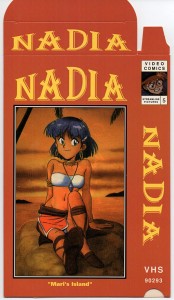
[#1-#7] “Confession first: this is not intended as an overall review of The Secret of Blue Water or Nadia and the Sea of Mystery as it was originally called. Rather, this is in the way of some initial impressions of the TV serial, based on the Streamline dubs of the first seven episodes.” “It’d be a pity to give away much of the story: most of the fun lies in the way the plot is gradually revealed, with different strands coming to the fore in each episode. Suffice to say Secret belongs to the same ‘alternate history’ genre as Laputa (with which it shares numerous plot similarities) and Wings of Honneamise (which involved Anno Hideaki, Secret’s animation director). The setting is the 19th century of classic romance, with lost worlds, hidden civilizations, and wonderfully anachronistic technology.” “Clearly aimed at older kids, the complex storyline touches on serious themes, including racism — Nadia feels out of place because of the colour of her skin, and Jean’s aunt dismisses her as a ‘coloured girl.’
“Those fazed by The Lion King, be warned, there’s a genuinely upsetting sequence in Part Six where a little girl is told of her family’s murder (imagine that getting past the campaigners for family viewing). More astounding yet, later on Nadia contemplates sacrificing the same girl to protect the Blue Water, a moral dilemma even modern Disney would blanch at. The draughtmanship is at the top end of TV anime. All the characters are well-designed, though the character animation is often irritatingly cheesy. The backgrounds are sumptuous — check out the early river scenes for layouts that would not have looked out of place in a quality cartoon feature. As for dubbing, once you get past some outrageous accents (was that really Star Trek’s Scotty on the Nautilus?) and the odd stilted line, it’s actually pretty good. Nadia and Jean come over as likable three-dimensional characters who you want to know, and I gather the question of Nadia’s origins dominates most of the story.” “Overall, Secret’s main asset is that it’s a rollicking good yarn. One imagines the story would work as well on the printed page as on screen, which is not true of many toons. With over ten hours of the saga to go, Secret of Blue Water promises to continue to intrigue and surprise, and I’ll be first in line to see the next episodes. Oh, and the theme tune is wonderful!”
Andrew Osmond, Animato!, #32, Spring 1995, pg. 53
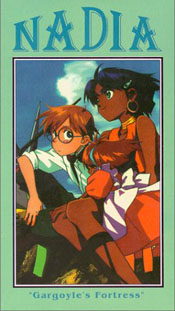
[#1-#8] “Great stuff! Originally aired on NHK TV in Japan in 1990 as a 39-episode animated series, NADIA (Japanese title translates to ‘Nadia of the Mysterious Seas’) is a cross-genre-cultural delight for action-adventure buffs of all ages. With references from period Jules Vernesian fantasia (the series was originally going to be an adaptation of 20,000 LEAGUES UNDER THE SEA and Nemo and the Nautilus crew figure prominently), AROUND THE WORLD IN EIGHTY DAYS, serials, Miyazaki’s LAPUTA and Nippon space and mecha operas, NADIA is boundlessly frenetic and imaginative fun, with enough hairbreadth escapes to make RAIDERS look tame. The plot, circa 1889, is a world-wide chase for the possession of a magic jewel (the eponymous ‘Blue Water’), currently in the keeping of exotic young beauty, Nadia.”
“Aided by a youthful French science prodigy and a gang of warm-hearted thieves, the orphaned girl (actually alien princess and daughter of Captain Nemo) quests for her origins while fending off evil designs of fascistic tech-oriented Neo-Atlanteans, who intend to use the jewel for a scheme of global domination. The first episodes set up a meeting between Nadia, boy inventor Jean, and Nautilus’ crew as they’re pursued by the rapacious Grandis Granva Gang and Neo-Atlanteans headed by the megalomanical Gargoyle.” “Filled with rich character development, surprisingly mature content, and blessed with a gorgeous and resourceful young heroine, NADIA is the kind of ‘Sense of Wonder’ roller-coaster ride which makes you recall every movie that enthralled you as a kid. Only sourpusses would pass on it. NADIA is also a singular achievement for xenophobic Japan, in being the first anime series to feature a non-white lead heroine.”
Todd French, Imagi-Movies, v.2 #4, Summer 1995, pg. 41
[#6] “This episode retains the charm of the previous ones.” “Nadia’s fans will find all the elements that make this series so appealing. For those who have not yet seen an episode of Nadia, it is an adventure series that appeals to everyone (something that does not come often!).”
Stephane Pierre, Protoculture Addicts, #23, May-June 1993, pg. 38
[#1] “… light-hearted fun, with a labyrinthine plot typical of the genre.
Glenn Kenny, Pulse!, #107, August 1992, pg. 84
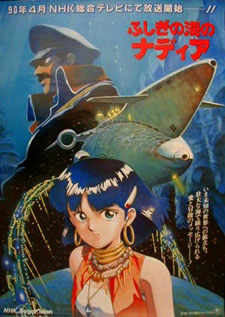
[#1] “Now, I’m a big Nadia fan. Many of my anime friends are as well. They aren’t happy about the treatment in the video. […] I like Streamline’s treatment. I am pleasantly surprised. So why? […] The voices, overall, are fine since they are the usual cast of Streamline regulars. […] The script is excellent. One or two jokes are omitted from the translation, and some of the lines are different, but overall it is great, and in some places quite inspired. […] One other comment is about the cleanness of the reproduction. My copy is just a notch under my tape of the Japanese 3-laserdisc compilation. […] Why do I like this version of Nadia while others have criticized it? It’s because I have approached viewing it without referring to the original. I’ve tried to look at it as if I were watching it for the first time, as if it were its own identity, not a conversion from Japanese to English. For me, it works. […] Having just made the statement that Streamline is a commercial enterprise, I then must say that they have done a good job on Nadia.”
Widya Santoso, The Rose, v.6 #33, July 1992, pg. 11
[#2] “The Nadia series offers something for both Japanese-animation aficionados as well as for those unfamiliar with this distinct style, since it features interesting characters, a well-written script and nonstop adventure.”
Tanya Laden, Wild Cartoon Kingdom, #4, 1994, pg. 69
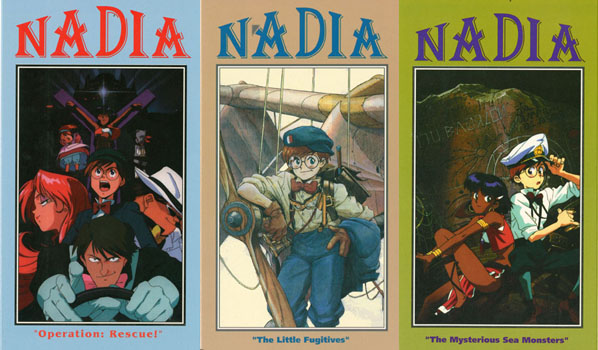
Next week: Guess what? More of the same.


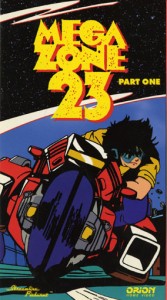
 Fred Patten (1940-2018) was an internationally respected comics and animation historian. He has written about anime or comic books for publications ranging from Animation Magazine and Alter Ego to Starlog. He was a contributor to The Animated Movie Guide (2005), and is author of Watching Anime, Reading Manga (2004, Stone Bridge Press), a collection of his best essays, and Funny Animals and More (2014, Theme Park Press), based upon his early columns here on Cartoon Research. He passed away on November 12th, 2018.
Fred Patten (1940-2018) was an internationally respected comics and animation historian. He has written about anime or comic books for publications ranging from Animation Magazine and Alter Ego to Starlog. He was a contributor to The Animated Movie Guide (2005), and is author of Watching Anime, Reading Manga (2004, Stone Bridge Press), a collection of his best essays, and Funny Animals and More (2014, Theme Park Press), based upon his early columns here on Cartoon Research. He passed away on November 12th, 2018.





































At least some liked the Streamline version at all. I always think of that very first VHS volume’s opening prologue obvious being very loosely put-together the way the English narration is clearly laid on top of the Japanese audio track! That aside, it’s not a bad release at all, and a shame it didn’t get past episode 8 otherwise.
I never understood that prologue. I didn’t think it was official when I first heard it because I watched other versions that had Michael McConnohie doing the prologue. Once I acquired a VHS copy of the first episode, I learned it was legitimate.
I still don’t know if the McConnohie prologue exists on VHS copies of the first episode or if it was created for the compilations released by Orion.
The Streamline dub of “Nadia” isn’t bad, but I felt it always lacked something, I thought the leads were miscast and not very well done. The accents were inconsistent as well.
The ADV dub also has some less than perfect accents, but dub-wise, it’s the better of the two overall. The VAs in that have a lot more heart and emotion to their parts, and I liked that they used children for the voices of Jean, Nadia, and Marie. It brought a lot of authenticity and intangibleness to their parts. It took me awhile to get used to Jean’s accent, but once I did I had no further troubles with his VA.
Yeah, the Streamline version made Jean and Nadia sound like they’re in their late teens the way they acted.
But that is a bad thing? I think not. I enjoyed hearing Ardwight Chamberlain and Wendee Lee in those roles.
There is no “better” Nadia dub. It is impossible to fairly compare them because the Streamline dub is incomplete. There may be voices you prefer, but even then, the Streamline cast didn’t get the opportunity to voice the characters beyond the first eight episodes. It will never be known how the Streamline cast would have performed in the rest of the series, preventing a direct comparison with the ADV dub.
To me, the Streamline dub of Nadia is a solid product with strong performances from the leads and consistent accents. The VAs bring plenty of heart and emotion to their roles and dare I say they performed better than their ADV counterparts across the first eight episodes. Using actual children does bring authenticity, but it also runs the risk of weaker performances and that’s unfortunately the case with the ADV dub for me. At the same time, even fans of the ADV dub admit the early episodes are the cast’s weakest performances and they improved as the series went on. Those “weaker performances” are the same ones being directly compared to the Streamline cast’s performances. We’ll never know how the ADV VAs compare to their Streamline counterparts when they got more acclimated to their roles. And I liked the ADV dub from what I’ve heard, which makes me wish there was a fair comparison between the dubs even more.